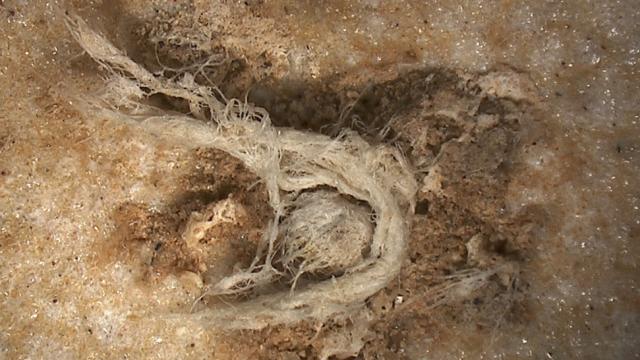Scientists working in the south of France have discovered a small Neanderthal cord fragment dating back to over 41,000 years ago. It’s now the oldest evidence of fibre technology in the archaeological record, and further testament to the remarkable cognitive abilities of these extinct humans.
Neanderthals manufactured glue, wore eagle talons as jewellery, decorated themselves with feathers, started their own fires, made cave paintings, and fashioned tools from seashells. We can now add fibre technology to this impressive list, thanks to new research published today in Scientific Reports.
Archaeologist Bruce Hardy, a researcher from Kenyon College in Ohio and the first author of the new study, said it’s further evidence that Neanderthal brain power was comparable to anatomically modern humans.
“The cord, and fibre technology in general, is an example of an infinite use of finite means,” Hardy told Gizmodo. “You start by twisting a set of fibres into a strand of yarn. Multiple yarns are twisted to form a court, multiple courts to form a rope, and so on. We cannot make a rope without the preceding steps. In that way fibre technology is very similar to language. We can’t have a sentence without words, we can’t have words without sounds that convey meaning. Thus, the cognitive abilities for making string and rope are very similar to those for making language. This speaks to the cognitive abilities of Neanderthals.”
Prior to this discovery, the oldest direct evidence of textile and cord technology came from the Ohalo II site in Israel. These cords, dated to 19,000 years old and linked to modern humans, were made from several fibres that were given a clockwise twist.
At the Abri du Maras site in southern France, archaeologists had previously found evidence of Neanderthal textile use in the form of single twisted fibres, but it wasn’t enough for scientists to be sure. The newly discovered cord fragment, also at Abri du Maras, is different because it’s composed of multiple fibres twisted into yarn that were then twisted back to form a cord.
“So this confirms our suspicions that Neanderthals were using fibre technology,” said Hardy.
The cord fragment is approximately 6.2 millimetres long and 0.5 mm wide, and it was found stuck to an old stone tool that measures 60 mm long. The authors speculate that the string was either used in a binding that attached the flake to a handle, or the cord came from a bag or other device used to carry the cutting tool.
The string was dated to between 41,000 and 52,000 years ago, which predates the arrival of modern humans to the region. These dates were derived from the stratigraphic layer in which the items were found. The Abri du Maras site is a well-known and well-documented Neanderthal stomping ground. Hardy said his team is “fully confident in the dates.” Scientists from the French National Centre for Scientific Research, Rovira i Virgili University in Spain, and other institutions contributed to the research.
Spectroscopic and microscopic analyses showed that the fibre was made from cellulose, which was likely sourced from the inner bark of a non-flowering tree, likely a conifer or evergreen tree.
“In order to get this fibre, you have to strip the outer bark off a tree to scrape off the inner bark,” explained Hardy. “This is best done in spring or early summer. Often, these fibres are soaked in water for a period of time before being broken down into individual fibres. At this point they can be twisted into string or rope.”
This means Neanderthals must’ve had a rich understanding of these trees and their growth patterns, as well as a sense of seasonality, according to the new research. Fascinatingly, Neanderthals would have also required some maths skills to make these cords, including an understanding of pairs, sets, and numbers.
“To make a string or rope, you have to understand some basic mathematical concepts,” said Hardy. “Pairs and sets of numbers are combined in different ways to make the cord structure. In this case, three bundles of fibres were twisted to make yarns, or strands, and then twisted in the opposite direction to make a cord. A set of three strands produces a stronger cord than just two. From there, pairs or sets of cords can be twisted to make larger and stronger ropes.”
[referenced url=” thumb=” title=” excerpt=”]
Truly wild stuff, and more proof that Neanderthals were a technologically savvy bunch. At the same time, Neanderthals were capable of providing social support, and they were not the violent brutes they were often portrayed to be. Their extinction, a process that began some 40,000 years ago, is all the more mysterious given these profound cognitive abilities.
